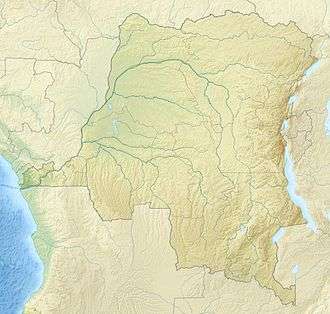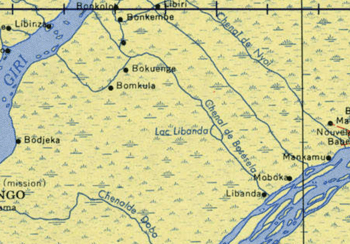Lake Libanda
| Lake Libanda Lac Libanda | |
|---|---|
 Lake Libanda | |
| Location | Makanza, Equateur, Democratic Republic of the Congo |
| Coordinates | 1°33′N 18°49′E / 1.55°N 18.82°ECoordinates: 1°33′N 18°49′E / 1.55°N 18.82°E |

Lake Libanda is a lake in the Democratic Republic of the Congo,[1] situated in the territory of Équateur Province to the west of the town of Makanza. The closest settlement is the village of Moboka to the southeast.[2]
History
The lake was visited in 1889 during the Congo Free State by Captain-Commander of the Force Publique (the Belgian colonial military unit in the Congo) Étienne-Christophe-Bernard-Eugène Wilverth, at the time as Commanding Officer of the training camp of Umangi in the town of Lisala.[3] Making a trip to the Ngiri River, he found that a so-called Lake Ibinza did not exist and instead discovered a channel from the village of Moboka to Lake Libanda and from there to the Ngiri, near the village of Bosesera.[3] This channel was named the Bosesera Channel.
A Christian mission named the Catholic Mission of Libanda operated in the region in the 1960s.[4]
Geography
The lake's surface area is 7.9 km2 (3.1 sq mi). Its maximum length is 4.5 km (2.8 mi) and its maximum width is 2.5 km (1.6 mi).[5]
The Bosesera Channel (French: chenal de Bosesera) is a stream which has its source in Lake Libanda, passing through Mabale before reaching the Congo River near Moboka, slightly downstream of Makanza.[6]
Demographics
The Libanda subgroup of the Libinza people (Libinja) inhabit the region surrounding Lake Libanda.[7][8] The other subgroup is the Boyokoko. They speak the Libinza language.
References
- ↑ L'Essentiel - Pays d'Afrique Centrale (in French). TheBookEdition. 2016-10-27. p. 53. ISBN 9782930815053.
- ↑ "Lac Libanda - Lake near Moboka, Democratic Republic of The Congo". MBendi.com. Retrieved 2017-01-31.
- 1 2 "Inst. roy. colon. belge Biographie Coloniale Belge, T. III, 1952, col. 926-928" (PDF).
- ↑ Mulumba, Mabi; Makombo, Mutamba (1986-01-01). Cadres et dirigeants au Zaïre, qui sont-ils?: dictionnaire biographique (in French). Editions du Centre de recherches pédagogiques. p. 72.
- ↑ Bossche, J.-P. vanden; Bernacsek, G. M. (1990-01-01). Source Book for the Inland Fishery Resources of Africa. Food & Agriculture Org. p. 316. ISBN 9789251029831.
- ↑ Kerken, Georges van der (1944-01-01). L'Ethnie mongo: histoire, groupements, sous-groupements, origines; visions, représentations et explications du monde; sociologie, économie, ergologie, langues et arts des peuples mongo, politique indigène, contacts avec peuples voisins (in French). Librairie Falk, G. van Campenhout. p. 186.
- ↑ Kerken, Georges van der (1944-01-01). L'Ethnie mongo: histoire, groupements, sous-groupements, origines; visions, représentations et explications du monde; sociologie, économie, ergologie, langues et arts des peuples mongo, politique indigène, contacts avec peuples voisins (in French). Librairie Falk, G. van Campenhout. p. 194.
- ↑ "Africa: The Libinza: River islands people of the Congo: Traditional cultures: village life. - Images | JungleView - Stock photographs by Jacques Jangoux". jangoux.photoshelter.com. Retrieved 2017-04-22.